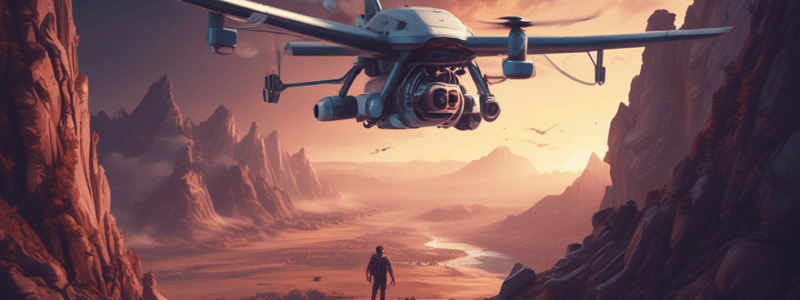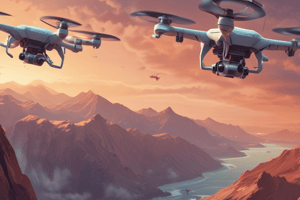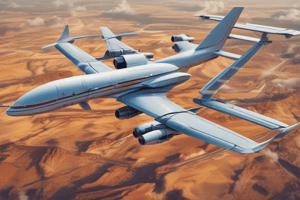Podcast
Questions and Answers
What is the purpose of the 'Display Radar Map' feature?
What is the purpose of the 'Display Radar Map' feature?
- To stop the drone from hitting obstacles
- To bypass obstacle avoidance
- To switch to FPV mode
- To show potential obstacles on the radar map (correct)
What happens when the 'Emergency Propeller Stop' is activated?
What happens when the 'Emergency Propeller Stop' is activated?
- The propellers stop spinning (correct)
- The drone returns to home
- The drone enters sport mode
- The drone lands immediately
What is the effect of changing the 'Tilt Smoothness' setting?
What is the effect of changing the 'Tilt Smoothness' setting?
- It modifies the obstacle avoidance system
- It affects the smoothness of the gimbal movement (correct)
- It adjusts the autofocus feature
- It changes the drone's flight mode
What is the recommended setting for 'Tilt Smoothness' and 'Tilt Speed'?
What is the recommended setting for 'Tilt Smoothness' and 'Tilt Speed'?
What is the purpose of the 'Find My Drone' feature?
What is the purpose of the 'Find My Drone' feature?
What is the max altitude for the 'Return to Home' feature?
What is the max altitude for the 'Return to Home' feature?
What happens when the drone is in 'Follow Mode'?
What happens when the drone is in 'Follow Mode'?
What can be customised using the 'Button Customization' feature?
What can be customised using the 'Button Customization' feature?
What is the purpose of calibrating the gimbal?
What is the purpose of calibrating the gimbal?
What is the 'Air Sense' feature used for?
What is the 'Air Sense' feature used for?
The 'Bypass' option for obstacle avoidance stops the drone from hitting thin objects like tree branches or power lines.
The 'Bypass' option for obstacle avoidance stops the drone from hitting thin objects like tree branches or power lines.
The 'Advanced Return to Home' feature works in Civil Twilight (early morning or late night).
The 'Advanced Return to Home' feature works in Civil Twilight (early morning or late night).
The 'Air Sense' feature never gives false alarms.
The 'Air Sense' feature never gives false alarms.
Changing 'Gains and Expos' can make the drone less responsive.
Changing 'Gains and Expos' can make the drone less responsive.
The 'FPV Mode' of the gimbal keeps the horizon line locked.
The 'FPV Mode' of the gimbal keeps the horizon line locked.
Flashcards are hidden until you start studying
Study Notes
Drone Settings
- Safety menu: accessed through three dots in the top right corner
- Obstacle avoidance options: Bypass ( Warning: may hit thin objects like tree branches or power lines), Break, or Off
- Display Radar Map: shows yellow and red lines indicating potential obstacles but won't stop the drone from hitting them
Return to Home
- Advanced return to home: flies an optimal route in adequate lighting, but not in Civil Twilight (early morning or late night)
- Preset option: flies straight up to a set altitude and then returns home
- Max altitude: 120m (approximately 400ft), can be adjusted
- Max distance: can be adjusted, but 400ft above the tallest point of a building is allowed within a 400ft radius
Find My Drone
- Feature causes ESCs to make a beeping sound to help locate a lost drone
- Can be turned on in case of lost drone
Advanced Safety Settings
- Signal loss: important to change if flying from boats, to prevent returning to home and potentially landing in water
- Return to home is perfect for flying from land
- Emergency propeller stop: for emergencies only
- Air sense: tells you when a plane is nearby and if you need to yield, but may give false alarms
Control
- Units can be changed from metric to Imperial
- Subject scanning: automatically scans and displays subjects in the camera view
- Expo and gain tuning: should not be changed until after flying the drone 5-10 times and understanding its response
Gains and Expos
- Specific to each flight mode (e.g., normal, GPS, sport)
- Changing gains and Expos can make the drone more responsive, but may affect smoothness of footage
Tilt Smoothness
- Controls how the gimbal moves up and down
- Tilt speed: how fast the gimbal moves up and down
- Autofocus: can be set to occur every time the gimbal is tilted up
- Deadband: the time it takes for the gimbal to stop moving after the tilt wheel is released
- Recommended settings: tilt smoothness 10 and tilt speed 13 for smooth reveals
Gimbal Mode
- Follow mode: gimbal follows the motion of the drone and stays horizon-locked
- FPV mode: gimbal moves with the roll of the drone, giving an FPV-like look
Gimbal Calibration
- Important to calibrate the gimbal to prevent IMU errors and potential crashes
- Check the IMU if the gimbal is showing an angled horizon line
Button Customization
- Syble tilt recenter and down for C1
- C1 can be changed to gimbal type, and C2 can be changed to auxiliary light
- Right dial can be changed to zoom or adjust focal length and shutter speed
- C1 plus right dial can adjust shutter speed, making it easy to achieve the perfect shutter speed for frame rate
Drone Settings
- Safety menu is accessed through three dots in the top right corner
- Obstacle avoidance options include Bypass, Break, or Off, with Bypass warning of potential collisions with thin objects
- Display Radar Map shows yellow and red lines indicating potential obstacles but won't stop the drone from hitting them
Return to Home
- Advanced return to home flies an optimal route in adequate lighting, excluding Civil Twilight
- Preset option flies straight up to a set altitude and then returns home
- Max altitude is 120m (approximately 400ft) and can be adjusted
- Max distance can be adjusted, with a minimum of 400ft above the tallest point of a building within a 400ft radius
Find My Drone
- Feature causes ESCs to make a beeping sound to help locate a lost drone
- Can be turned on in case of lost drone
Advanced Safety Settings
- Signal loss is important to change if flying from boats, to prevent returning to home and potentially landing in water
- Return to home is perfect for flying from land
- Emergency propeller stop is for emergencies only
- Air sense tells you when a plane is nearby and if you need to yield, but may give false alarms
Control
- Units can be changed from metric to Imperial
- Subject scanning automatically scans and displays subjects in the camera view
- Expo and gain tuning should not be changed until after flying the drone 5-10 times and understanding its response
Gains and Expos
- Specific to each flight mode (e.g., normal, GPS, sport)
- Changing gains and Expos can make the drone more responsive, but may affect smoothness of footage
Tilt Smoothness
- Controls how the gimbal moves up and down
- Tilt speed is how fast the gimbal moves up and down
- Autofocus can be set to occur every time the gimbal is tilted up
- Deadband is the time it takes for the gimbal to stop moving after the tilt wheel is released
- Recommended settings are tilt smoothness 10 and tilt speed 13 for smooth reveals
Gimbal Mode
- Follow mode: gimbal follows the motion of the drone and stays horizon-locked
- FPV mode: gimbal moves with the roll of the drone, giving an FPV-like look
Gimbal Calibration
- Calibrating the gimbal is important to prevent IMU errors and potential crashes
- Check the IMU if the gimbal is showing an angled horizon line
Button Customization
- Syble tilt recenter and down for C1
- C1 can be changed to gimbal type, and C2 can be changed to auxiliary light
- Right dial can be changed to zoom or adjust focal length and shutter speed
- C1 plus right dial can adjust shutter speed, making it easy to achieve the perfect shutter speed for frame rate
Drone Settings
- Safety menu is accessed through three dots in the top right corner
- Obstacle avoidance options include Bypass, Break, or Off, with Bypass warning of potential collisions with thin objects
- Display Radar Map shows yellow and red lines indicating potential obstacles but won't stop the drone from hitting them
Return to Home
- Advanced return to home flies an optimal route in adequate lighting, excluding Civil Twilight
- Preset option flies straight up to a set altitude and then returns home
- Max altitude is 120m (approximately 400ft) and can be adjusted
- Max distance can be adjusted, with a minimum of 400ft above the tallest point of a building within a 400ft radius
Find My Drone
- Feature causes ESCs to make a beeping sound to help locate a lost drone
- Can be turned on in case of lost drone
Advanced Safety Settings
- Signal loss is important to change if flying from boats, to prevent returning to home and potentially landing in water
- Return to home is perfect for flying from land
- Emergency propeller stop is for emergencies only
- Air sense tells you when a plane is nearby and if you need to yield, but may give false alarms
Control
- Units can be changed from metric to Imperial
- Subject scanning automatically scans and displays subjects in the camera view
- Expo and gain tuning should not be changed until after flying the drone 5-10 times and understanding its response
Gains and Expos
- Specific to each flight mode (e.g., normal, GPS, sport)
- Changing gains and Expos can make the drone more responsive, but may affect smoothness of footage
Tilt Smoothness
- Controls how the gimbal moves up and down
- Tilt speed is how fast the gimbal moves up and down
- Autofocus can be set to occur every time the gimbal is tilted up
- Deadband is the time it takes for the gimbal to stop moving after the tilt wheel is released
- Recommended settings are tilt smoothness 10 and tilt speed 13 for smooth reveals
Gimbal Mode
- Follow mode: gimbal follows the motion of the drone and stays horizon-locked
- FPV mode: gimbal moves with the roll of the drone, giving an FPV-like look
Gimbal Calibration
- Calibrating the gimbal is important to prevent IMU errors and potential crashes
- Check the IMU if the gimbal is showing an angled horizon line
Button Customization
- Syble tilt recenter and down for C1
- C1 can be changed to gimbal type, and C2 can be changed to auxiliary light
- Right dial can be changed to zoom or adjust focal length and shutter speed
- C1 plus right dial can adjust shutter speed, making it easy to achieve the perfect shutter speed for frame rate
Studying That Suits You
Use AI to generate personalized quizzes and flashcards to suit your learning preferences.




